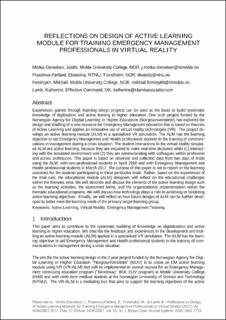Reflections on design of active learning module for training emergency management professionals in virtual reality
Peer reviewed, Journal article
Published version
Permanent lenke
https://hdl.handle.net/11250/3054950Utgivelsesdato
2017Metadata
Vis full innførselSamlinger
- Artikler [412]
- Publikasjoner fra Cristin [429]
Originalversjon
NOKOBIT: Norsk konferanse for organisasjoners bruk av informasjonsteknologi. 2017, 25 (1).Sammendrag
Experiences gained through learning design projects can be used as the basis to build systematic knowledge of digitization and active leaning in higher education. One such project funded by the Norwegian Agency for Digital Learning in Higher Educations (Norgesuniversitetet) has explored the design and trialling of a new resource for Emergency Management education that is based on theories of Active Learning and applies an innovative use of virtual reality technologies (VR). The project de-velops an active learning module (ALM) in a specialized VR simulation. The ALM has the learning objective to aid Emergency Management and Health professional students in the training of communi-cations in management during a crisis situation. The student interactions in the virtual reality simulat-ed ALM are active learning, because they are required to make real-time decisions while (1) interact-ing with the simulated environment and (2) they are communicating with colleagues within profession and across professions. This paper is based on observed and collected data from two days of trials using the ALM, with non-professional students in April 2016 and with Emergency Management and Health professional students in March 2017. The purpose of this paper is not to report on the learning outcomes for the students participating in these particular trials. Rather, based on the experiences of the trial-runs, the educational module (ALM) designers will reflect on the educational challenges within the thematic area. We will describe and discuss the elements of the active learning design such as the learning activities, the assessment forms, and the organizational implementation within the thematic educational programs. We will discuss how technology plays a role in achieving or hindering active learning objectives. Finally, we will reflect on how future designs of ALM can be further devel-oped to better meet the learning needs of the primary target learning group. Keywords: active learning, virtual reality, emergency management training
